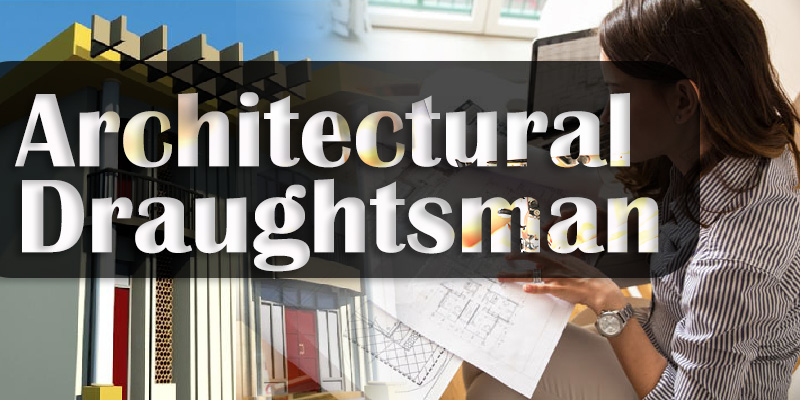
The "Architectural Draughtsman" trade under the Craftsman Training Scheme (CTS) by the National Council for Vocational Training (NCVT) typically spans two years and focuses on developing skills in architectural drafting, drawing, and related technical abilities. Below is the syllabus in English for the ITI Trade "Architectural Draughtsman," covering Trade Theory, Trade Practical, Workshop Calculation and Science, Engineering Drawing, and Employability Skills.
1. Trade Theory
This section provides the theoretical knowledge necessary for creating architectural drawings and understanding construction principles.
Year 1
- Introduction to Draughtsmanship
- Role of an Architectural Draughtsman in construction projects.
- Importance of precision in architectural drawings.
- Drawing Instruments and Tools
- Use and care of drafting tools (e.g., T-square, set squares, compass).
- Overview of manual and digital drafting methods.
- Building Materials
- Types and properties of materials (e.g., bricks, concrete, timber, steel).
- Applications in construction.
- Construction Techniques
- Basics of foundations, walls, floors, roofs, and staircases.
- Understanding masonry, RCC (Reinforced Cement Concrete), and steel structures.
- Architectural Drawing Basics
- Types of drawings: plans, elevations, sections, and perspectives.
- Scales, symbols, and conventions in architectural drafting.
- Building Bylaws
- Introduction to local building regulations and zoning laws.
Year 2
- Advanced Architectural Design
- Principles of design: symmetry, balance, and proportion.
- Planning residential, commercial, and public buildings.
- Structural Detailing
- Reinforcement details for beams, columns, and slabs.
- Structural steel drawings.
- Computer-Aided Drafting (CAD)
- Introduction to CAD software (e.g., AutoCAD).
- Commands for 2D and 3D drafting.
- Estimation and Costing
- Basics of material estimation and cost calculation.
- Preparation of Bills of Quantities (BOQ).
- Surveying and Leveling
- Principles of land surveying and its role in drafting.
- Use of leveling instruments.
2. Trade Practical
This hands-on component develops drafting and technical skills.
Year 1
- Manual Drafting
- Draw lines, angles, and geometric shapes using drafting tools.
- Create simple plans, elevations, and sections of buildings.
- Lettering and Dimensioning
- Practice architectural lettering styles.
- Apply dimensions and annotations to drawings.
- Building Component Drawings
- Sketch foundations, doors, windows, and staircases.
- Draw masonry and roofing details.
- Model Making
- Construct basic 3D models of structures using cardboards or other materials.
Year 2
- Advanced Drafting
- Prepare detailed working drawings for residential and commercial buildings.
- Draw structural details (e.g., RCC beams, columns).
- CAD Practice
- Create 2D architectural plans and 3D models using CAD software.
- Print and plot drawings from CAD.
- Site Exposure
- Visit construction sites to observe and sketch real-world applications.
- Assist in basic surveying tasks.
- Project Work
- Draft a complete set of architectural drawings for a small building project (e.g., house plan with elevations and sections).
3. Workshop Calculation and Science
This section covers mathematical and scientific principles relevant to drafting.
- Mathematics
- Calculations for areas, volumes, and scales.
- Trigonometry for angles and slopes in drawings.
- Science
- Properties of materials (e.g., strength, elasticity).
- Basics of forces, loads, and structural stability.
4. Engineering Drawing
This focuses on technical drawing skills specific to architectural applications.
Year 1
- Fundamentals
- Draw orthographic projections of simple objects.
- Use architectural symbols and conventions.
- Building Drawings
- Create plans, elevations, and sections with proper scaling.
Year 2
- Detailed Drawings
- Draw structural components (e.g., reinforcement details).
- Develop isometric and perspective views.
- Working Drawings
- Produce construction-ready drawings with all specifications.
5. Employability Skills
This enhances professional skills for job readiness.
- Communication
- Effective interaction with architects, engineers, and clients.
- Workplace Skills
- Time management, teamwork, and problem-solving.
Course Overview
- Duration: 2 years
- Eligibility: Passed 10th class examination under the 10+2 system with Science and Mathematics or equivalent.
- Objective: To train individuals in preparing architectural drawings, using CAD tools, and assisting in construction projects, preparing them for roles like Architectural Draughtsman, CAD Operator, or Site Assistant.
This syllabus aligns with the NCVT framework but may vary slightly by state or institution. For precise details, consult the Directorate General of Training (DGT) website or local ITI resources. The course prepares students for careers in architectural firms, construction companies, and design consultancies. Let me know if you need only specific sections (e.g., Trade Theory or Trade Practical) for your purposes!
Trade Type
- 15 views